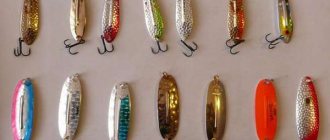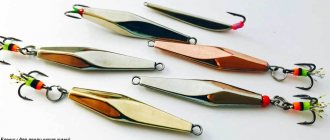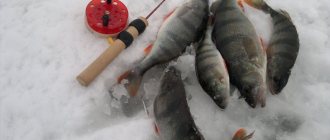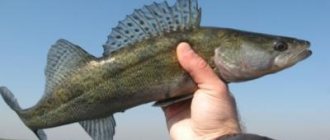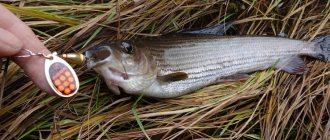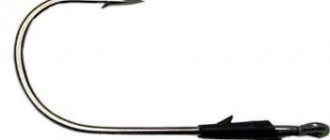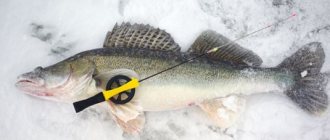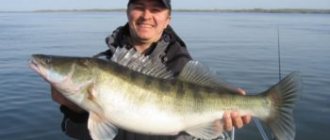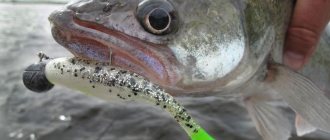Homemade spoons for winter and summer vertical fishing for pike perch are posted in the photographs. A link to material with the technology for making the simplest working zander lures with your own hands is at the end of the topic.
The page continues the description of my pike-perch spinners with drawings of homemade baits for vertical fishing for pike-perch with a winter or summer fishing rod. After reading the page, you will be able to make any pike perch spoon from the drawings collected for your convenience in the archives.
Below in the text, when watching the video, you can choose for winter - summer fishing, in addition to pike perch spoons, vertical baits for perch or homemade baits for pike and at the same time look at the elements of the hook equipment.
Winter vertical lures for pike perch
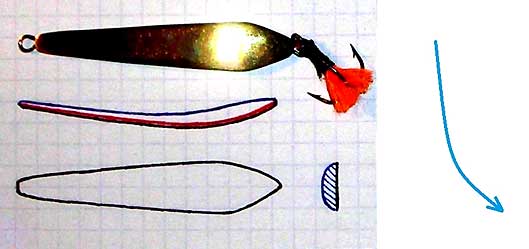
Sheer spoons for catching pike perch are usually called winter ones, but many fishermen catch fanged predatory fish with a vertical rod in the summer. It is better to fish with a fishing rod about a meter long from a rubber boat, rafting down the weak current of the river.
Having felt the knock on the “winter” spoon or caught a pike perch, you can put the floating craft on one anchor and fish the “suspicious” place all around, given that pike perch is a schooling fish. True, this does not mean at all that a pike perch will definitely land on a steep pike perch spoon.
Instead of pike perch, large perch, pike and other predatory fish may covet the double (tee) hooks of a homemade or purchased pike perch bait, which, I hope, should not upset us too much. In deep holes in the summer, pike perch can be caught well with tubular vertical spoons.
Drawing of a sheer pike perch spoon pattern
The photo under the title of the article shows a drawing of a pattern for a homemade sheer lure for pike perch with a movable tee equipped with a panicle made of woolen threads. Let them be called “winter” on the pages of this topic.
The figure next to it shows the characteristics of a long vertical line with a winter fishing rod with vertical equipment for a bait made according to the drawing.
We will talk further about winter pike perch, vertically gliding spoons. Archives with sets of drawings of patterns for winter homemade spinners for pike perch, pike perch and pike perch can be downloaded from the Main page.
For the convenience of further tracking the text, download the archive of drawings of winter pike-perch spinners. And making a vertical winter lure for pike perch with a minimal set of tools is not at all difficult, even for a novice fisherman.
Personally, during my long life I have caught and continue to catch fish in winter and summer, including pike perch, only with my own made bait. Otherwise, where would I have gotten the drawings of perch, zander and pike homemade vertical lures?
Spoons for catching pike perch in the current
Spoons for catching pike perch with a winter or summer fishing rod in a plumb line on fast river currents are shown in the picture. These are heavy baits of almost straight action with camouflage hooks equipped with pieces of mohair yarn.
The length of homemade winter pike perch spoons is in the range of 70-90 mm. The length to width ratio is in the corridor 7-8/1. Explanations about the size of pike perch spoons.
River currents, where pike perch are often caught vertically, force spoons to be filled with heavy alloys and the baits to be given an elongated shape.
Heavy spoons for vertically trolling pike perch with a winter fishing rod are loaded with high petals filled with POS-18 solder, the center of gravity is shifted to the “nose” of the bait. (1/3 away from the nasal end of the body).
The vertical wiring of heavy homemade pike-perch spinners, elongated spinners, in real conditions of fishing for pike-perch on the river flow is almost monotonous, despite the fact that the tees are equipped with artificial nozzles.
Volumetric hairs on the movable hooks of vertical winter baits stabilize the trajectories of spinners when catching pike perch at a decent pressure of the river current.
Tees with volumetric equipment are simply pulled along the stream of water; the strong current does not allow triple or double hooks to rest on the bodies of vertical pike-perch baits during their lower retrieves.
But it is better, of course, on spinners designed for catching pike perch with winter fishing rods on strong river currents, to have the hook elements soldered into the bodies of vertical baits.
The recommended diameter of monofilament when catching pike perch with a vertical spoon on the river currents where we usually fish (Volga, Kama, Vetluga) is 0.25-0.3 mm; braid can be used with a diameter of 0.18-0.2 mm.
Boat for vertical fishing for pike perch
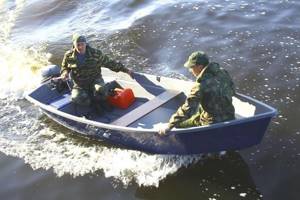
It is advisable to take a boat with a flat bottom and comfortable benches. To move around a body of water, such watercraft are equipped with gasoline engines with a power of 10-15 hp.
On a note! For vertical fishing for pike perch, it is optimal to use two boat motors at once - electric and gasoline. A low-power electric motor is used for slow, silent movement around a promising area. A gasoline engine with a power of more than 10 hp. necessary for quickly moving from one fishing spot to another, quickly returning to the shore in case of heavy rain or big waves.
We recommend reading: Fishing for carp: how to properly catch carp in a pond and on a river
Important. The use of inflatable boats in vertical fishing is less preferable since they are less stable in waves and strong currents. In addition, inflatable boats are easily pierced by sharp bait hooks.
Pike-perch spinner rig for current

The rigging of my pike-perch spinners for catching pike-perch with a short rod from a boat or from ice on river currents consists of soldered loops and doubles with artificial baits.
Various types of swivels on steep winter lures do not protect the fishing line well from twisting. But extra attachments unpredictably spoil the wiring of perch and pike-perch spoons, especially in the current.
It is unpredictable, because the combination of a winding ring and a tee, with each subsequent casting of the same winter pike-perch spoon, can take any position on the bait that is different from what it occupied during the previous casting, even when fishing for pike-perch in a body of water with no current.
Moreover, with this method of equipping winter purchased and homemade pike-perch spinners with hook elements, the uniformity of the wiring of vertical baits, even on weak river currents, significantly suffers.
Whether pike perch likes the sound of iron attached to a spoon is a topic for another discussion. But I have not yet heard from anyone about live bait that, dodging the teeth of a predatory fish, rattled its bones with all its might.
But our homemade and purchased winter spinners for catching perch, pike perch, and pike should, in theory, imitate the sounds produced by live bait, and not ring with an extra suspended iron.
Beginning fishermen can equip the jigs and sheer zander, perch and pike winter lures that you already have, both homemade and industrially made, in their own way or bring the existing equipment to mind, using the tips laid out in the article Catching baits - eliminating defects
Gear equipment
Spinning
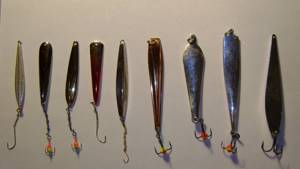
To collect gear, you need to have a reel, fishing line, and bait on hand. To prevent fishing from becoming exhausting with constant casting, you need to choose a spinning rod that is quite light and comfortable, 2-4 m in length, to be able to cast bait over long distances.
When fishing from a boat, a rod length of up to 1.8 m is sufficient. If you take it longer, then carrying it from the boat will be completely inconvenient. The rod should be stiff and the action should be fast.
To carry out powerful hooks when fishing with a spinning rod in the depths, heavy baits are used, so the rod test can reach up to 40-50 g.
With live bait
Live bait tackle includes donka, mugs, and float rods . The main thing with this equipment is to choose a thicker fishing line (its parameters are described above) and good live bait. It is better to provide the tackle with a float when fishing in the roots. This will make casting with a sliding float more accurate.
But you shouldn’t wait long for bites; the pike perch should bite quickly. Otherwise, it simply does not exist in this place. It is worth covering promising places in a larger volume for more successful fishing. Open, clean areas are suitable for bottom fishing.
Pike perch is good for bleak with a narrow body, just to match the throat of a predator. Minnows, minnows, and bindweed are successful as bait.
Nod for catching pike perch with a spinner
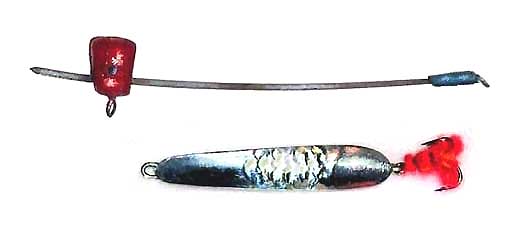
The nod for catching pike perch, which is an element of the equipment of a winter fishing rod, complete with a winter vertical spoon, is shown in the photograph. I don’t think that this fishing device plays a secondary role on any trolling rod. Therefore, I will try to formulate my requirements for a nod that works in real conditions of pike perch fishing.
Firstly: since we catch pike perch with vertical spoons of different weights, it means that the nod spring must have the ability to adjust the stiffness of the shock absorber. This can be achieved by changing the length of the nod spring and the shape of its bend.
Or, in real conditions of pike perch fishing, you will have to match the nod spring structure of a winter fishing rod to the weight in the water of a vertical pike perch spoon.
The width of the springs of my homemade nods for catching pike perch with sheer spoons gradually decreases towards the ends with loops. It is probably unnecessary to mention that we can only give a forced bend to compensate for the weight of a pike-perch spoon in the water to a nod plate made of spring metal.
Secondly: the elasticity of the nod spring when fishing with vertical winter lures (not only pike perch) should be selected in such a way that the shock absorber most clearly tracks all stages of the pike perch bait and at the same time minimally affects them.
Tuned nod for catching pike perch
When fishing for pike perch with a winter fishing rod with a vertical spinner, the spring of an incorrectly adjusted nod can quite noticeably move upward when the load of the pike perch bait applied to it changes significantly.
This happens after the sheer lure for pike perch, after retrieving the top and then dropping the rod of the fishing rod to the hole at the end of the planning trajectory, selects the supply of dropped fishing line and with its mass acts on the nod spring, bending it down.
After this, due to the excessively elastic properties of the metal plate, a sharp rise of the spring may occur, which, in turn, will cause a failure in the wiring of the winter vertical spoon, which the pike perch may not really like.
Setting the nod spring for catching pike perch
Typically, the nod springs on fishing rods for catching pike perch with vertical spoons in water bodies with a current are adjusted so that the angle of inclination of their end parts to the horizon level is 10-15 degrees. The metal plate of the nod must be loaded with the selected vertical spoon.
In real conditions of catching pike perch in a current, the weight of a vertical pike perch spoon in the water will decrease, but the additional load of the current force will begin to put pressure on the nod spring, so that in general the structure of the spring can remain approximately the same.
How to catch pike perch with a vertical lure. Video.

It is known that pike perch can rightfully be considered a worthy rival among predators, and pike perch also occupies not the last place among culinary recipes and various dishes.
The method and technique of catching pike perch using vertical lures is known to few fishermen. But there are still specialists who catch pike perch this way. Since this method of catching pike perch is effective and also exciting. The technique of catching pike perch requires the angler to have certain knowledge, patience and attention. Making tackle for vertical trolling for pike perch is not difficult. To do this you will need a fishing rod 0.5m long. or a whip of approximately the same size, which can be removed from an old fishing rod. Next, let's look at gear for vertical fishing, which is available in any fishing store.
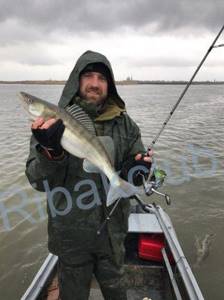
Let's start with selecting a coil. Any reel, spinning or inertial, is suitable for a fishing rod. The fishing method requires that the reel quickly release the line, since pike perch fishing is carried out mainly at depths. For this purpose, the fishing line is selected from approximately 0.35 to 0.45 mm. This diameter of the fishing line is selected taking into account that it does not damage the fisherman’s hands. And with all this, it was noticed that with a thin fishing line, the game of the spinner and bites is much worse than what is indicated in this case. And it is also important that if you have a tight fishing line, you should not tie leashes, as this will worsen the performance of the spinner.
It is known that a predator, and in this case pike perch, very rarely bites through the fishing line and there is no need to be afraid of losing the lure. Now let's look at an important part of the gear. The spinner is the active part of the vertical spinner. And it’s not worth telling what the spinner looks like. Surely not all anglers know that not all spoons are suitable for plumb trolling. These spoons are rarely sold in fishing stores. Its ideal size is about 2 cm in width, and as for its length, it should be approximately 12 cm.
In order to understand what it looks like, it is very similar to a fish without any bends, and the color of the spoon used for vertical fishing should directly depend on the soil of the reservoir. And this is chosen like this: if the bottom of the reservoir is sandy, then we choose the color of the spoon to match the tone of the soil, in this case it will be yellow.
We found out that the bottom is rocky, then we choose the color of the spinner silver. Having some experience in making spinners, it is better to make them yourself, since the analogues offered in fishing stores will not give the desired result and effect in vertical spinners. For vertical fishing, fishermen usually make their own spinners.
JOKE OF THE DAY A fisherman sits near the hole and catches fish. A local resident approaches him and says: “Excuse me, I see you here often.” – Yes, I’ve been coming here for five years. “But don’t you know that there are no fish in this lake?” - Well, two years ago I began to have suspicions...
Next, choose a place to catch pike perch. Surely you have such a place, and if not, then read on the website, where everything is written out and clear. And if there is something you don’t understand for yourself, then it’s worth finding out from experienced fishermen; it will be a pleasure to share it with novice fishermen. A little about pike perch we can say that this fish is quite capricious. It is usually caught in rainy weather, accompanied by wind.
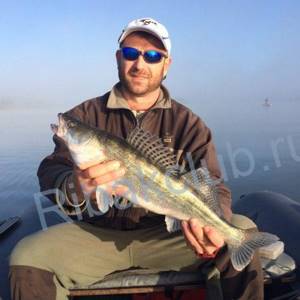
And if you find yourself in excellent weather, meaning complete calm and clear sky, without a single cloud and clear sun, then pike perch is unlikely to be caught vertically. Having studied the weather and location, you can safely learn the technique of vertically fishing for pike perch. This technique is quite simple. We lower the spoon into the water and place it on the bottom of the reservoir, as in the winter version with a balancer, raise the spoon 5-10 cm from the bottom.
After adjusting the distance of the spoon from the bottom, we proceed directly to trolling with bait, which consists of twitching the spoon upward and smoothly lowering it to its original place, it is when the spoon is lowered that the long-awaited bite of the pike perch occurs. It is also worth considering that the lure does not need to be done in one place, but rather move the fishing rod with the bait a little, then there will be a real effect of the bait and the correct release of it to the bottom at a slight angle. Pike perch, especially large ones, are extremely cautious; they stop feeding if they hear or feel something unusual around them and soon go to the depths of the reservoir. When the water level in a reservoir rises, pike perch can be easily caught from the shore, along the coastline, and for this you can use rotating lures for pike perch.
Equipment for homemade zander lures
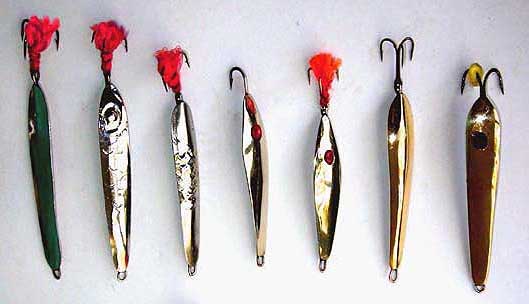
For some fishermen, equipping homemade pike perch spoons may be the last operation before tying a vertical winter bait to the fishing line. I have to equip my homemade zander lures with the necessary elements during the soldering process.
The fact is that I am an opponent of all unnecessary attachments dangling on vertical winter lures (not only pike perch), and if you have not visited this site for the first time, then you probably know about this.
Let's now try to understand the equipment elements of the bodies of homemade pike perch spoons, shown in the photograph under the title of the article.
Please note that none of my homemade pike perch spoons have winding rings. The mobility of the tees is carried out by hinges connected to them and soldered into the nasal ends of the baits.
Such equipment increases the stability of gliding trajectories not only of pike perch, but also of any vertical lures controlled by short winter fishing rods.
There are no swivels on the tail ends of homemade pike-perch spinners, which still do not fully cope with their duties as anti-twist mono-core or braid in the process of catching pike-perch.
Therefore, the fishing line of the winter fishing rod is tied directly to the loop of a vertical homemade winter pike perch spoon. Thanks to simplified equipment, greater stability is achieved in guiding vertical baits in real pike perch fishing conditions.
If we look at all my homemade walleye lures, then about a third of them are dominated by single-hook equipment with artificial nozzles, and in a third, doubles and trebles are soldered into the bodies of the baits.
The reason for such equipment is the hard, bony mouth of the pike perch, which is easier to pierce with one needle, and not with two at once, and, especially, not with three tees.
And the likelihood of a deep puncture will be much greater if all the needles are rigidly fixed in the body of the bait. And I talked about equipping homemade and purchased winter pike perch baits with tees suspended on spinners through winding rings.
You can get acquainted with the equipment, shape, and color of sheer homemade spinners for pike perch, perch and pike in a short video.
